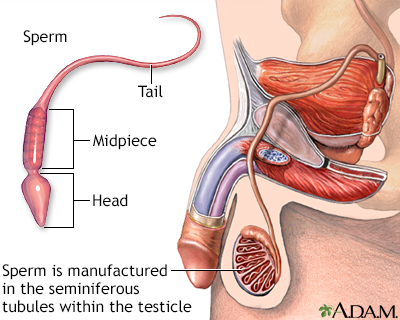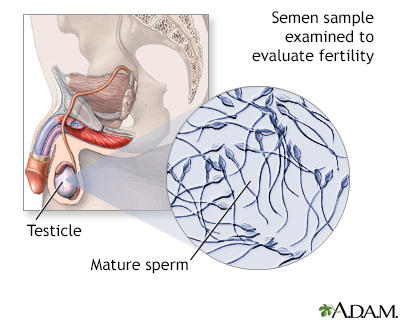Semen analysis
Male fertility test; Sperm count; Infertility - semen analysis
Semen analysis measures the amount and quality of a man's semen and sperm. Semen is the thick, white fluid released during ejaculation that contains sperm.
This test is sometimes called a sperm count.
Images


Animation


How the Test is Performed
You will need to provide a semen sample. Your health care provider will explain how to collect a sample.
Methods for collecting a sperm sample include:
- Masturbating into a sterile jar or cup
- Using a special condom during intercourse given to you by your provider
You should get the sample to the lab within 30 minutes. If the sample is collected at home, keep it in the inside pocket of your coat so that it will stay at body temperature while you are transporting it.
A laboratory specialist must look at the sample within 2 hours of the collection. The earlier the sample is analyzed, the more reliable the results. The following things will be evaluated:
- How the semen thickens into a solid and turns to liquid
- Fluid thickness, acidity, and sugar content
- Resistance to flow (viscosity)
- Movement of the sperm (motility)
- Number and structure of the sperm
- Volume of semen
How to Prepare for the Test
In order to have an adequate sperm count, do not have any sexual activity that causes ejaculation for 2 to 3 days before the test. However, this time should not be longer than 5 days, after which the quality can diminish.
How the Test will Feel
Talk to your provider if you are uncomfortable with how the sample is to be collected.
Why the Test is Performed
Semen analysis is one of the first tests done to evaluate a man's fertility. It can help determine if a problem in sperm production or quality of the sperm is causing infertility. About half of couples unable to have children have a male infertility problem.
The test may also be used after a vasectomy to make sure there are no sperm in the semen. This can confirm the success of the vasectomy.
The test may also be performed for the following condition:
Normal Results
A few of the common normal values are listed below.
- The normal volume varies from 1.5 to 5.0 milliliter per ejaculation.
- The sperm count varies from 20 to 150 million sperm per milliliter.
- At least 60% of the sperm should have a normal shape and show normal forward movement (motility).
Normal value ranges may vary slightly among different laboratories. Talk to your provider about the meaning of your specific test results.
An abnormal result does not always mean there is a problem with a man's ability to have children. Therefore, it is not completely clear how the test results should be interpreted.
What Abnormal Results Mean
Abnormal results may suggest a male infertility problem. For example, if the sperm count is very low or very high, a man may be less fertile. The acidity of the semen and the presence of white blood cells (suggesting infection) may affect fertility. Testing may reveal abnormal shapes or abnormal movements of the sperm.
However, there are many unknowns in male infertility. Further testing may be needed if abnormalities are found.
Many of the causes of male infertility are treatable.
Risks
There are no risks.
Considerations
The following may affect a man's fertility:
- Alcohol
- Many recreational and prescription drugs
- Tobacco
Related Information
InfertilityVasectomy
Klinefelter syndrome
References
Jeelani R, Bluth MH. Reproductive function and pregnancy. In: McPherson RA, Pincus MR, eds. Henry's Clinical Diagnosis and Management by Laboratory Methods. 24th ed. Philadelphia, PA: Elsevier; 2022:chap 26.
Swerdloff RS, Wang C. The testis and male hypogonadism, infertility, and sexual dysfunction. In: Goldman L, Cooney KA, eds. Goldman-Cecil Medicine. 27th ed. Philadelphia, PA: Elsevier; 2024:chap 216.
BACK TO TOPReview Date: 3/31/2024
Reviewed By: Sovrin M. Shah, MD, Associate Professor, Department of Urology, The Icahn School of Medicine at Mount Sinai, New York, NY. Review provided by VeriMed Healthcare Network. Also reviewed by David C. Dugdale, MD, Medical Director, Brenda Conaway, Editorial Director, and the A.D.A.M. Editorial team.

Health Content Provider
06/01/2025
|
A.D.A.M., Inc. is accredited by URAC, for Health Content Provider (www.urac.org). URAC's accreditation program is an independent audit to verify that A.D.A.M. follows rigorous standards of quality and accountability. A.D.A.M. is among the first to achieve this important distinction for online health information and services. Learn more about A.D.A.M.'s editorial policy, editorial process and privacy policy. A.D.A.M. is also a founding member of Hi-Ethics. This site complied with the HONcode standard for trustworthy health information from 1995 to 2022, after which HON (Health On the Net, a not-for-profit organization that promoted transparent and reliable health information online) was discontinued. |
The information provided herein should not be used during any medical emergency or for the diagnosis or treatment of any medical condition. A licensed medical professional should be consulted for diagnosis and treatment of any and all medical conditions. Links to other sites are provided for information only -- they do not constitute endorsements of those other sites. © 1997- 2025 A.D.A.M., a business unit of Ebix, Inc. Any duplication or distribution of the information contained herein is strictly prohibited.
